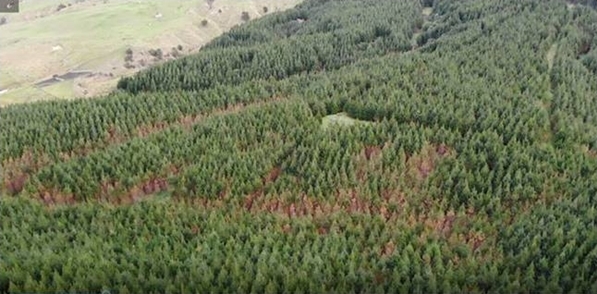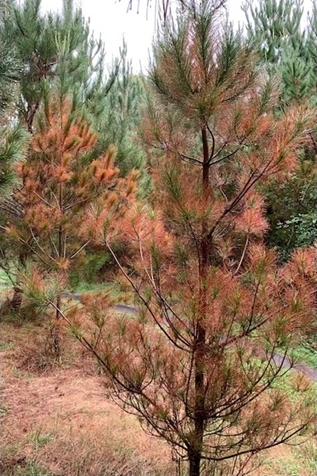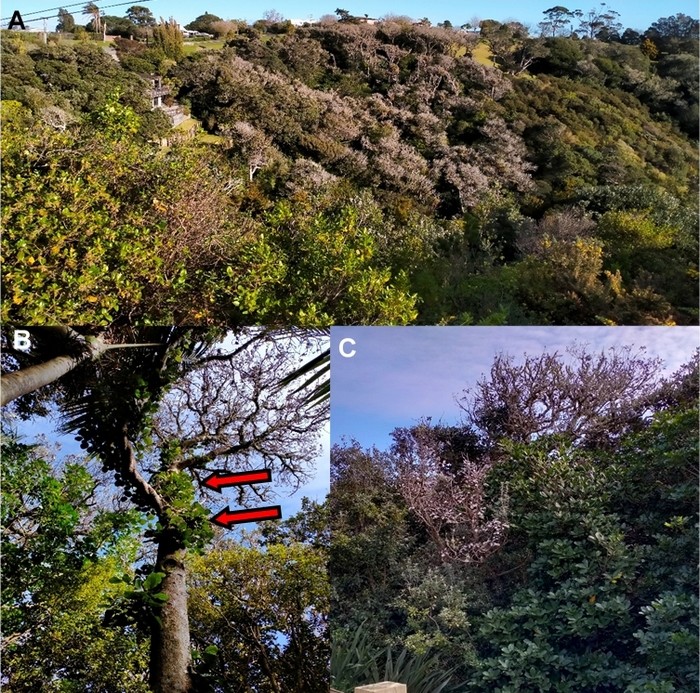Forest Health News No. 312 - December 2022
The achievements of Dothistroma management in New Zealand
Dothistroma needle blight (Dothistroma septosporum) was first noted in NZ in 1962 and spread to susceptible areas rapidly. It was widespread in the North Island and upper South Island by the end of the decade. Severe effects in the South Island are generally only found in wetter areas such as the West Coast.
As a fungal disease, Dothistroma thrives in moist warm areas and where conditions are suitable, quickly causes death of needles that then fall off the tree. Infection levels above about 25% of the green crown can result in significant loss of growth. Trees that have been repeatedly infected are often very easy to distinguish due to small diameter, small and often dead lower branches, and poor foliage retention. These trees are often in gullies (as seen in the photo below) and on ridge tops where moisture persists.

Given the rapid rise in infection levels and impact on growth, FRI as it was then, turned its attention to how adverse effects might be reduced.
Copper is a well-known fungicide and used extensively in various forms worldwide. Spraying of forests however is more problematic and not widely practiced either in NZ or elsewhere in the world. Scientists from FRI (firstly John Gilmour and then John Ray) quickly tested and developed methods for applying copper fungicides aerially to large areas of forest.
The Dothistroma Control Committee was established in 1966 to coordinate the control of this disease. The Committee was formed by the NZ Forest Service with support from large private forest owners. At that time, the NZFS managed over half the planted forest estate and had the staff and resources to support the effort.
The role of the Committee initially included supporting the research programme, assessing the extent of infection each year through aerial surveys, purchasing sufficient copper for the programme and coordinating the application of the spray.
In the early days, application was by fixed wing aircraft (helicopters in NZ were still small, rare and were not widely used for agricultural and forestry work).

Early research demonstrated an application of 4.16kg of copper oxychloride in 50 litres of water in late spring provided control of the disease.
The scientists along with support from NZFS managers and private forest managers sought to continually improve the management of the disease and in the early 1980s recommended a profound change to the application methodology. Technology changed from traditional large droplet nozzles to micronairs, achieving the tiny drops required to get coverage from low volume spraying.
The addition of oil to the mix, and using drift spraying with fine droplets gave excellent coverage of needles and hence control of disease. The real benefit came from significantly lower application rate – 5 litres per hectare with only 1.66kg copper oxychloride and 2 litres of oil. Substantial cost savings were achieved, better control and greater ability to optimise suitable spray days as an aircraft could now treat 100 hectares with a load instead of 10 hectares each load.
Environmentally there were also advantages in these changes, although, these were not major drivers for the change at that time.
Helicopters were also becoming more common in forestry and agriculture and were used increasingly in hilly areas or small forest blocks. Today, helicopters have largely taken over completely from fixed wing aircraft for Dothistroma control spraying.
In the late 1990s, new technology for producing copper fungicides became available. This coincided with the start of the economic transformations in China. Copper fungicides were often produced from recycled copper, which often had impurities from solder, such as lead. As China grew, they began buying all the ‘scrap’ copper in the world forcing fungicide manufacturers to turn to newly mined copper sources.
These manufacturers also developed cost effective technology for manufacturing cuprous oxide, which became a more cost competitive alternative to oxychloride. In turn, due to the greater amount of copper in oxide (75%) compared to oxychloride (50% copper), further reductions in application rates become possible with the same or potentially improved control due to the lower solubility of oxide compared to other copper compounds.
Today, forest owners apply 1.14kg of cuprous oxide with 2 litres of oil made up to 5 litres with water. Some owners are even using 3 litres of spray mix being the copper and oil only. The scientists have not only focused on treatment technology but most radiata tree stocks have an increased level of Dothistroma resistance bred into them than previous generations of trees.
The Dothistroma Control Committee, now in its 56th year, continues to support innovative research, focusing on application technology, alternatives to copper and environmental impact studies. The committee also continues to support forest owners, sourcing copper and oil at competitive rates and coordinating spray programmes to get the most effective outcomes for forest owners, large and small.
The Committee is an outstanding example of all forest owners working together to achieve a common goal of healthy productive forests, supported by excellent ongoing research.
Don Hammond and Lindsay Bulman
Taraire (Beilschmiedia tarairi) decline in the Auckland region
Taraire is in the genus Beilschmiedia, which has 273 accepted species around the world, mainly in tropical and sub-tropical regions. Taraire grows in New Zealand from North Cape, to Raglan and the East Cape. It grows best on well drained fertile soils and does not tolerate poor drainage or very dry sites. Its fruit are an important food source for kererū in late spring and early summer. It has a highly decorative timber, which has been used for flooring and furniture since the 1950s.
It is reported that taraire has been declining in Auckland and Northland since one of the worst droughts in these regions’ history in the summer of 2019/2020. Taraire has continued to decline and is now very evident with skeleton crowns of taraire dominating some ngahere and pockets of native bush. This lack of recovery indicates that some pathogen maybe persisting in the drought stressed trees. Taraire mortality has also been linked to a severe drought in 2010.
Waiheke Island is one site where severe ongoing decline of taraire has been noted since the 2019/20 drought (Figure 1). Scion and Manaaki Whenua Landcare Research (MWLR) staff visited Waiheke Island in August 2021. Samples were collected under MWLR permits, CS101 for Regional Parks and LOA 20-308 Auckland Council reserves.
Five sites were visited on the Island and samples of soil and dieback were collected. Soil baiting yielded Phytophthora multivora from one site, and Phytopythium vexans and Fusarium oxysporum from all sites. Phytophthora multivora, an important pathogen of multiple plant hosts, has also been associated with several native host species, including kauri, rimu and tōtara. It has been shown to be pathogenic to kauri [1], Eucalyptus and Banksia species in Australia [2, 3] and the endangered Wollemi pine in Australia [4]. Recent pathogenicity tests at Scion with P. multivora on pōhutukawa and tōtara were inconclusive as the pathogen was inconsistently reisolated from soil and roots. This is the first record of this pathogen on taraire. Phytopythium vexans is a pathogen on many horticultural crops and ornamental woody hosts in New Zealand and overseas [5, 6]. It has been associated with several of New Zealand’s native species, including kauri, pōhutukawa, pūriri, rimu and tōtara. Recent pathogenicity testing of Pp. vexans on pōhutukawa seedlings and tōtara showed it caused root rot and in the case of the pōhutukawa, reduced the root mass compared to control plants. This is the first report of Pp. vexans on taraire. Fusarium oxysporum is a species complex and ranges from being saprophytic, to a weak, secondary or primary pathogen. Further work would be required to understand what role, if any, this fungus is playing in the decline of taraire. This is also the first time F. oxysporum has been recorded on this host.
From three sites where dieback was sampled, isolations yielded Diplodia pseudoseriata from one site, a Colletotrichum species from one site and a Diaporthe species from two different sites. All these genera have the capacity to act as endophytes, saprophytes, weak or primary pathogens. This is the first time D. pseudoseriata has been reported from taraire and only the second time it has been reported from New Zealand.
The severe decline of taraire in the Auckland and Northland regions is of concern. If recovery is successful, it will take decades to regain the crown density that has been lost in this episode that has been instigated by the severe drought of 2019/2020. It’s likely that when the 2019/2020 drought started, taraire was still recovering from the severe drought of 2010. Further work is required for us to understand what role these pathogens or potential pathogens are playing in the decline of taraire, including wider sampling across New Zealand, pathogenicity testing, as well as a look at historical weather data to uncover patterns of taraire decline. With the results from these samples, we can move forward with discussions on how to address this issue with interested parties such as Iwi, DOC and regional councils.
Peter Johnston (Manaaki Whenua Landcare Research) and Kiryn Dobbie (Scion)
[1] Horner, I. and E. Hough, Pathogenicity of four Phytophthora species on kauri in vitro and glasshouse trials. New Zealand Plant Protection, 2014. 67: p. 54-59.
[2] Scott, P., et al., Pathogenicity of Phytophthora multivora to Eucalyptus gomphocephala and Eucalyptus marginata. Forest Pathology, 2012. 42(4): p. 289-298.
[3] Migliorini, D., et al., Extending the host range of Phytophthora multivora, a pathogen of woody plants in horticulture, nurseries, urban environments and natural ecosystems. Urban Forestry & Urban Greening, 2019. 46: p. 126460.
[4] Puno, V., et al., Detection of Phytophthora multivora in the Wollemi Pine site and pathogenicity to Wollemia nobilis. Australasian Plant Pathology, 2015. 44(2): p. 205-215.
[5] Baysal-Gurel, F., et al., First report of Phytopythium vexans causing root and crown rot on flowering cherry in Tennessee. Plant Disease, 2021. 105(1): p. 232.
[6] Jabiri, S., et al., Phytopythium vexans associated with Apple and Pear Decline in the Saïss Plain of Morocco. Microorganisms, 2021. 9(9): p. 1916.

Happy Holidays
Wishing everyone a happy and relaxing holiday after a year of many accomplishments and challenges. Also wishing our busy scientists and technicians’ good luck for their critical project work over Christmas and the New Year.
Ecology & Environment Research Group
Newsletter of the Scion Ecology and Environment team. Edited by Andrew Pugh and Darryl Herron, Scion. Contact: Andrew Pugh
